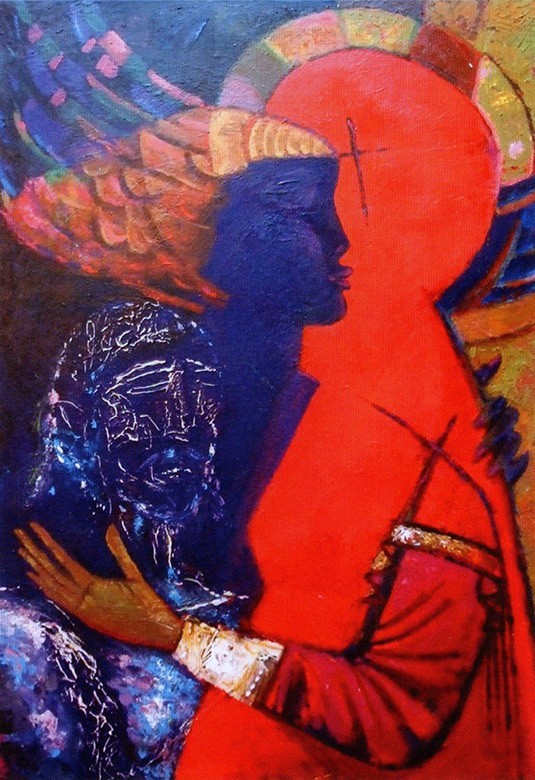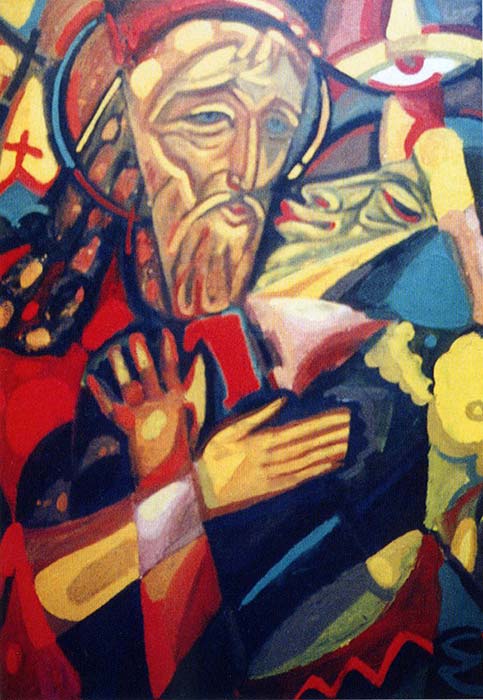Once in India, I touched a warm stone statue bathed in the sun. In front of me stood a stone goddess who was many centuries old. And I thought: “Lord, if you created us in your image and likeness, then what should be the originals there, in heaven!”.
Hey! This text has been translated into English using automatic Google translation. So I apologize for the inaccuracies in the text. The original in Russian can be seen here
With these words, Nikolai Dundin recalls his trip to India. Of course, this journey had a huge impact on the entire work of the artist. There he closely, one might say closely, got acquainted with the mysterious world of legends, myths and the art of the people and great masters of ancient India. Therefore, now, on the canvases of the author, one can easily find not just echoes, but direct references to topics related to the East and this most interesting country, with its culture and traditions. However, an artist can never be so unambiguous and narrow in his views that he does not see everything else, except, for example, the art of India. Images of Vitebsk, the Christian religion, still lifes and portraits live in the paintings of Nikolai Dundin. The author, like a real creative person, is interested in everything that surrounds him. Therefore, on the canvases of the artist you can see a wide variety of plots, themes and sub-themes. They reflect a rich inner world, through the prism of which everything that he recognizes, sees, and feels passes. At the same time, the incoming knowledge, information is refracted and its awareness is realized. It is precisely on how the artist understands and accepts this world that his choice of means and form of expression of his feelings and emotions depends. Since any picture is certain ways of creating it, i.e. various means and forms of expression. Consequently, there is a direct connection between the inner world and the image depicted on the canvas. And the work of Nikolai Dundin is no exception to all the rules. In them one can easily find all the features inherent in a creative person, the author of paintings, who not only reflects external reality like in a mirror, like a camera, but, passing through the essence of his inner world, perceives and tries to understand and realize it. Thus, deeply delving into the problems that concern the artist, Dundin spills the whole gamut of feelings and emotions onto the canvases, showing the rich essence of the author’s psychology, introducing particles of mythology into the work. It manifests itself in the work of Nikolai from different sides. It may also be a reflection of the specific mythology of a particular people. For example, the myths of India. This theme is not only constantly traced on the artist’s canvases, but also affects his work in general. The author’s trip to this country, with its ancient traditions, beliefs and myths, had a significant impact on his perception of all reality. The attitude to the world has changed, his work has changed. They became brighter, louder and much more picturesque. They have a lot of bright colors, colors and shades. The artist’s canvases are quite colorful and rich. However, this does not prevent him from creating harmonious and beautiful paintings in terms of scale. For example, if you take the work “Dance of Shiva”, then the dancing figures immediately catch your eye. Namely, Shiva in the center in the background and on the left is a seated woman with fruit. Everything is written in bright colors, yellow-orange hues. It would seem that everything is juicy, saturated, which is even too much, but everything is not so simple. The artist has a subtle flair and perfectly combines both seemingly “wild” colors and opposite ones, and sometimes almost “all the colors of the rainbow” are found in the picture. On the one hand, this is not in favor of the author. It may seem that the creator does not own the technique and does not know how to put everything together harmoniously at work. However, this is not at all the case. His canvases can serve as proof. After all, it was in them that Nikolai Dundin fit both his excellent command of technique, in terms of the overall setting of the composition and color scheme, and the ability to “weave” a certain idea into the structure of the work. On the example of the painting “Dance of Shiva”, it can be seen that the author used an ancient myth about an Indian deity. This is a specific mythology of a certain country. And there are many such examples in the work of Nikolai Dundin.

From Indian themes, one can name such works as “Young God”, “Krishna – the God of Love”, “King Ashok” and others. In all these works there is one or another myth of this ancient country. They perfectly reflect the main features inherent in the culture of that time. Among them are the following – the third eye of Shiva, oriental decoration, the presence of clothes in the national style (hoodies, loincloths, belts, and others), scimitar, columns and other interiors of that time, and the people themselves (the shape of the eyes, postures and manner of execution). Thus, Indian mythology is reflected in the artist’s works.

However, the author in his paintings manages to perfectly reflect other trends in world mythology. Namely, we can name such as Greek myths (“Cleopatra”, “Socrates”), Christian myths (“Way of the Cross”, “Messenger”, “Kiss of Judas”), elements of urban mythology (“Wine, bread, Vitebsk”) and the author’s mythology (“A snail on a walk”, “Spring”, “A fairy tale for adults”). As can be seen from these few examples, the artist constantly refers to the theme of mythology. He has a rather diverse range of topics, myths, which he takes as a basis. For example, a large number of works are devoted to the religious myths of Christianity. Take, for example, “Kiss of Judas”. The master uses a composition of two images: blue and red. The latter refers to Jesus Christ. Proof of this is a small cross depicted near the head, a halo around it, and the very color of the figure. It is warm, hot and symbolizes the blood that Christ shed for us, being crucified on the cross. As for the second image, it is Judas. He is in blue robes, which means cold and betrayal. But the most important thing is the facial expressions. Jesus Christ at work is depicted as kind, bearded and inviting confidence, while Judas has an unpleasant, flattering face of a greenish tint.

Herald





With the same depth and thoroughness, one can consider other works by Nikolai Dundin related to the section of mythology. This makes it possible to better understand what the author wanted to say at one point or another. For example, in the work “Still Life with Pears”, the artist depicts pears on the table, a leaf. It would seem that everything is banal and simple, but they look like female figures and each of them has an image of a woman attached to it, exactly repeating a pear. This is a very difficult compositional move to understand. One can only guess what the artist really wanted to convey with this – a pleasant dish or a simple comparison. You can guess for a long time. But one thing should be said right away – this work belongs to the category of creative or author’s mythology. And in this perspective, modern artists often begin to spill all their fantasies onto the canvas, including and smoothly weaving all sorts of myths into them. Such canvases are always very difficult to understand and interpret.

Thus, we can conclude that the work of Nikolai Dundin is saturated with all sorts of mythology from various countries and peoples, certain directions of myths (whether urban, or author’s or any other). Such diversity makes us think about the complexity and depth of penetration into the topic by the author. After all, in fact, the works illuminate the chosen directions well and help to penetrate into this or that myth in more detail. I would like to hope that the artist will not stop there and will continue to work in the mythological aspect of art.











УДК 7,0
Материал опубликован в книге “Образование XXI века: материалы X (55) итоговой научно-практической конференции студентов и магистрантов, Витебск, 24-25 марта 2010 г. / Вит. гос. ун-т; ред.-кол.: А.П. Солодков (гл. ред.) [и др.] – Витебск: УО “ВГУ им. П.М. Машерова”, 2010. – 241-242 с.”
Вячеслав Шайнуров, Витебск, УО «ВГУ им. П.М. Машерова»



